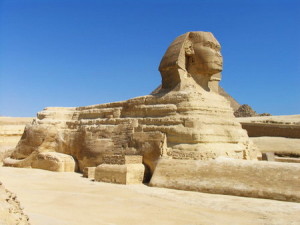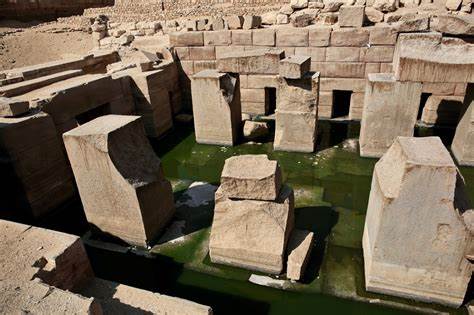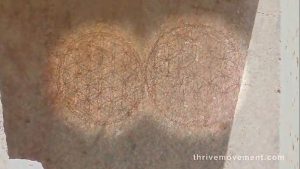John Anthony West
Lawton, Ian *
 Ian Lawton (1959- ) is an English researcher focused on ancient history and spiritual philosophy. He is probably best known as the co-author with Chris Ogilvie-Herald of Giza: The Truth [1690], which offers a sober forensic review of all the many and widely varied theories relating to the ancient structures on the Giza Plateau. In it, Lawton was highly critical of Robert Bauval‘s Orion Correlation Theory (OCT) both in the book (chapter 9)(d) and in open correspondence between them.
Ian Lawton (1959- ) is an English researcher focused on ancient history and spiritual philosophy. He is probably best known as the co-author with Chris Ogilvie-Herald of Giza: The Truth [1690], which offers a sober forensic review of all the many and widely varied theories relating to the ancient structures on the Giza Plateau. In it, Lawton was highly critical of Robert Bauval‘s Orion Correlation Theory (OCT) both in the book (chapter 9)(d) and in open correspondence between them.
However, Lawton was at the receiving end of criticism from the late John Anthony West in 2000, when West published an article in Atlantis Rising magazine that ended with a scornful “The point is that the facile assurances given by Ogilvie-Herald/Lawton endorsing the orthodox view are illegitimate, their exclusion of contrary, genuinely informed opinion is typical of their selective bogus scholarship, and their long-winded acoustic levitation hypothesis is pure speculation and self-contradictory besides. We still don’t know how the pyramids were built/ Period. Full stop.”(e)
Two years later Ogilvie-Herald co-authored Tutankhamun [1898] with Andrew Collins.
Lawton has also been highly critical of the claims of the late Zechariah Sitchin(b) and his book Mesopotamia: The Truth [1751], he returns to the subject.
Lawton’s second book, Genesis Unveiled [1691], has been described as containing “remarkable new insights into the spirituality of the pre-flood human race”. Chapter 13 takes a somewhat generous view of Blavatsky and Theosophy(c).
He subsequently made changes(a) to the content and, in my opinion, opportunistically re-titled it as Atlantis: The Truth! In it Lawton has focused on prediluvian races, citing, with reservations, the work of Stephen Oppenheimer, Arysio dos Santos and Frank Joseph, which when added to Lawton’s research, he concludes that “it’s nevertheless interesting that all four of us have independently arrived at the same conclusion about the broad whereabouts of any forgotten race.” He argues that the location of such a race was in the general region of Sunda and Sahul Shelves.
(a) Atlantis: The Truth | Ian Lawton (archive.org) *
(b) Mesopotamia: The Truth | Ian Lawton (archive.org) *
(c) Atlantis: The Truth | Ian Lawton (archive.org) *
(d) Giza the Truth | Ian Lawton | Chris Ogilvie-Herald (archive.org) *
(e) Atlantis Rising magazine #23 http://www.pdfarchive.info/index.php?pages/At
Tompkins, Peter
 Peter Tompkins (1919-2007) was an American journalist, WWII spy and perhaps best known as the author of the 1971 book, Secrets of the Great Pyramid[783] which included an extensive appendix by Livio Catullo Stecchini on the relationship of Ancient Measures to the Great Pyramid.
Peter Tompkins (1919-2007) was an American journalist, WWII spy and perhaps best known as the author of the 1971 book, Secrets of the Great Pyramid[783] which included an extensive appendix by Livio Catullo Stecchini on the relationship of Ancient Measures to the Great Pyramid.
Tompkins also wrote Mysteries of the Mexican Pyramids as well as over a score of other books on various ‘fringe’ subjects as well as his wartime exploits. He was interested in the mystery of Atlantis and to that end, he went to the Bahamas to study the ‘Bimini Road’ but concluded that it was only beach rock.
A later interview with Tompkins son, Ptolemy, revealed that his “dad was convinced that the Edgar Cayce readings about the rising of Atlantis were correct. He spent thousands and thousands of dollars photographing the limestone formations off Bimini – the so-called “Bimini Road.” My father loved the idea of Atlantis returning because he wanted the world to become a kind of new Eden. He was a true father of the New Age in this sense – he had the core New Age belief that the world once was, and would be again a better place. But not better in some mundane sense, but in the sense of being elevated back into a spiritualised condition that it had fallen away from. That’s what the Bimini stuff was all about” (a). Apparently, Tompkins left Bimini unconvinced that it had Atlantean credentials.
Tompkins wrote the foreword to the English translation of Otto Muck’s book, The Secret of Atlantis [0098] and was impressed by Muck’s hypothesis of Atlantis in the Atlantic being destroyed by an asteroid and considered the work of Cesare Emiliani important in support of this contention.
>In the Preface to John Anthony West’s Serpent in the Sky [452], Tompkins wrote that “interestingly, West develops de Lubicz‘ notion that the Egyptian cosmology and understanding of this universe was not endemic to Egypt but came from colonists or refugees from Plato’s sunken continent of Atlantis, which could also explain the similarities and identities with the cosmologies of Central America, presumably brought there by other refugees from Atlantis”!<
Sphinx
The Sphinx (at Giza) is considered by many to be considerably older than the usually accepted 3rd millennium BC. Its construction has been generally attributed to the Fourth Dynasty ruler Khafre, circa 2500 BC, whose head is believed to be currently represented on the Sphinx.
The controversial French scholar Rene Schwaller de Lubicz investigated several of Egypt’s ancient monuments.  He was probably the first to remark on the apparent water erosion, on the Sphinx, as evidence of an earlier date for its construction than was previously accepted. He first voiced his views in 1949[449] and expanded his theories in 1957 [450]. His work has now been translated into English(a).
He was probably the first to remark on the apparent water erosion, on the Sphinx, as evidence of an earlier date for its construction than was previously accepted. He first voiced his views in 1949[449] and expanded his theories in 1957 [450]. His work has now been translated into English(a).
Jason Colavito has added that “Schwaller de Lubicz got it from Gaston Maspero, who adopted it from Auguste Mariette, who came up with it because he mistook a Ptolemaic stela for an Old Kingdom one and therefore mistook a myth on the Inventory Stela(t) for a historical account.”(s)
However, in an extensive 2018 paper by Manu Seyfzadeh and Robert Schoch, they argue for the historical value of the Stele noting in the paper’s abstract that; “The Inventory Stele tells a story about Khufu and the Great Sphinx which contradicts the current mainstream narrative of when the Sphinx was carved. The story’s historical relevance has long been challenged based on its mention of names and certain details which are believed to be anachronistic to the time of Khufu. Here, we address the elements commonly cited by the critics one by one and find that they are largely based on misconceptions in part due to errors and oversights contained in the two commonly referenced translations and based on a missing context which relates to the economics and symbolism of supplying provisions to the royal house.”(z)
A recent article(h) on the Giza for Humanity website reveals the work of Shérif El Morsi, an Egyptian researcher, who has documented evidence of a ‘relatively recent’ incursion by seawater onto the Giza Plateau.>Morsi’s conclusions was exaggerated by some media headlines to suggest that he was proposing a total submergence of the Sphinx and pyramids(aj). However, Ivan Petricevic offers a more sober interpretation of Morsi’s claim(ak).<
Michael Baigent has pointed out[141.167] that Dr Zahi Hawass in 1992 ‘reported that analysis of the rear leg of the Sphinx proved the earliest level of masonry around the body dated instead from the Old Kingdom period, that is from about 2700 BC to 2160 BC. The pyramids were constructed in the middle part of this period…….. For if Khafre had built the Sphinx along with his pyramid around 2500 BC, and if repairs to its heavily eroded body were made before 2160 BC, then this severe erosion covered up by the facing stones must have occurred in only 340 years – perhaps less: an extremely unlikely event. In practical terms, given the extent and depth of the erosion, it seems impossible.’
John Anthony West was inspired by the writings of de Lubicz and enticed the American geologist Robert Schoch to inspect the Sphinx and give his professional assessment of the age of the monument. Schoch concluded that the Sphinx had suffered extensive water erosion and should be dated no later than 7000 to 5000 BC. On a second trip to the Sphinx Schoch and West brought Thomas Dobecki, a geophysicist, to carry out additional tests. The results reinforced Schoch’s initial conclusions. More recently, Schoch has pushed back his date for the Sphinx to around 10,000 BCE(ae).
In 1996 Graham Hancock and Robert Bauval published The Message of the Sphinx [1542] in which they endorse Schoch’s water erosion theory. but considered his date to be too conservative. Instead, they proposed that around 10,500 BC was more appropriate! However, Colin Reader, an English geologist, disputes Schoch’s conclusion(I) and explains why in an extensive 1997/9 paper(j).
>Furthermore, Chris Ogilvie-Herald, co-author with Ian Lawton of Giza: The Truth has published a paper, Climate Change and the Great Sphinx, in which he purports to demonstrate “the assertion made by Prof. Robert Schoch and John Anthony West that the Sphinx predates dynastic Egypt by many thousands of years is erroneous.” (ai)<
When Schoch announced his findings they were greeted with hostile criticism from conventional Egyptologists. A. Harrell, a Professor of Geology at Ohio’s University of Toledo, was probably the first geologist to challenge Schoch’s geological arguments in 1994(v).
However, experts in Schoch’s discipline have agreed in growing numbers with his published views, but the debate is far from over. For an overview of the case for an early date follow this link(b).
One Egyptologist who postulated an early date for the Sphinx was Cairo-born Moustafa Gadalla, who concluded that “there is no other rational answer except that the water erosion occurred at the end of the last Ice Age c.15,000-10,000 BCE”(e). Concerning the traditional attribution of the building of the Sphinx to Khafre, Gadalla refers to the ‘Inventory Stela’ and notes that “This stela describes events during the reign of Khufu, Khafra’s predecessor and indicates that Khufu ordered the building of a monument alongside the Sphinx. This means that the Sphinx was already there before Khufu and therefore could not have been built by his successor, Khafra. The stela was dismissed by some because its stylistic features appeared to be from the New Kingdom. This is not a sufficient cause to dismiss it, since there are numerous stelae and texts from the Old Kingdom that were later copied in the New Kingdom and no one dismissed their authenticity.”(y)
The German researcher Klaus Aschenbrenner has added his support for an early date for the Sphinx. He claims that the water erosion was caused by acid rain resulting from a 7600BC asteroid impact postulated by Alexander Tollman.
Mark Carlotto has proposed an even earlier date of 21,000 BCE, based on the work of Charles Hapgood. He contends in a 2021 paper that the Sphinx may have been part of a lunar temple aligned with the rising of a full moon!(af)
These proposed early dates pale into insignificance when contrasted with the claims made by two Ukrainian researchers at a conference in Sofia in 2008 when they proposed a date of 800,000 years ago(n), an approximate date which their paper(u) explains is also based on a study of water erosion, but unlike Schoch, who investigated the effects of rainwater on the Sphinx, Manichev & Parkhomenko focussed their attention on horizontal wave-cut hollows that correspond to a time of higher sea-levels and greater intrusion into the Nile Valley.
There is by now little doubt that the head of the Sphinx that we see today is quite different from its original size and shape. West had a New York City police artist, Lieutenant Frank Domingo, compare the head of the Sphinx with a known head of Khafre and demonstrated that they had distinctly different facial structures(ac). Comparative photographs are to be found in one of West’s books[453]. A further anomaly is the fact that the head of the Sphinx is disproportionately smaller than the rest of the body suggesting a radical recarving of a larger head in antiquity. Robert Schoch has an interesting article(c) on his website, written by his colleague, Dr Colette Dowell, regarding the shape of the Sphinx’s head. Colin Reader, who disagrees with Schoch’s dating of the Sphinx does, however, share his view regarding the size of the Sphinx’s head(l), an opinion that is also held by architectural historian, Dr Jonathan Foyle(k).
Schoch has now suggested that the Sphinx was originally carved in the shape of a lioness(ac). 25 years ago Richard Waters proposed that the head of the Sphinx had been designed as a lion(ah)*.
Not only is the identity of the Sphinx disputed, but even its race and gender are questioned(ad).
The late Alan Alford argued that the commonly accepted idea that the Sphinx represents a lion may be incorrect and that it is a model of a dog, possibly intended as an image of Anubis the divine guardian of the Earth and the Underworld. This idea was recently endorsed and investigated extensively in a fascinating book[622] by Robert Temple, who has also pointed out(m) other anomalies with the shape of the Sphinx apart from the size of the head.
Bassam el Shamma, an Egyptian Egyptologist, has recently promoted the idea of the previous existence of a second sphinx on the Giza Plateau. His theory, based on a range of evidence, is outlined on the Atlantis Online website(d). The idea of a second Sphinx is also supported by Gerry Cannon and Joseph P. J. Westlake in a paper also available online(f). Cannon has co-authored a book(r) with Malcolm Hutton, entitled The Giza Plateau Secrets and a Second Sphinx Location Revealed, in which they expand on this idea.
Antoine Gigal, the French researcher, has posted a two-part paper offering the evidence that originally there had been two sphinxes(w)(x).
>Mark Lehner, a leading pyramid expect, published his views on the dating of the Sphinx controversy in a 1994 article, later published on the Hall of Ma’at website(al). Evan Hadingham publish a review of Lehner’s opinion of the Sphinx in the Smithsonian magazine of February 2010(ab).<
Robert Bauval whose book, Secret Chamber[859], delves deeply into the subject of hidden chambers on the Giza Plateau and has excerpts available on the internet(p).
Paul Jordan the well-known Atlantis sceptic is also the author of a book [0415] on the Sphinx.
It should also be kept in mind that sphinxes were found in several other cultures particularly Mesopotamia (see image right). Further east in India we have the Purushamriga(q), while in Burma the sphinx is known as a Manussiha. Back in the Mediterranean, many images of sphinxes have been discovered in Greece, where lately (2014) two sphinxes were recently found in a 300 BC tomb(g), each weighing about 1.5 tons. However, in my opinion, the claim(o) of a huge sphinx in Romania’s Carpathian Mountains is nothing more than a case of mistaken identity, a good example of pareidolia.
Closer to home the Welsh Griffon (Gryphon) is a local form of a sphinx. Lee R. Kerr is the author of Griffin Quest – Investigating Atlantis[807], in which he sought support for the Minoan Hypothesis based on his pre-supposed link between griffons and Atlantis or as he puts it “whatever the Griffins mythological meaning, the Griffin also appears to tie Santorini to Crete, to Avaris, to Plato, and thus to Atlantis, more than any other single symbol.” I don’t see it.
The Atlantic magazine published an interesting collection of photos of the Sphinx dating from 1849 until the present.(aa)
(a) https://web.archive.org/web/20191030091005/https://www.sacredscience.com/store/commerce.cgi?page=Schwaller2.htm
(b) https://www.davidpbillington.net/sphinx2.html
(d) https://atlantisonline.smfforfree2.com/index.php?topic=9747.0
(e) See: Archive 2937
(g) https://www.seeker.com/sphinxes-emerge-from-huge-ancient-greek-tomb-1768972697.html
(h) See: Archive 2635
(i) https://www.youtube.com/watch?v=GAykfUMCw54
(j) See: Archive 2646
(m) https://globalwarming-arclein.blogspot.ie/2015/10/what-was-sphinx.html
(n) Scientists: Geological evidence shows the Great Sphinx is 800,000 years old (archive.org)
(o) See: Archive 3003
(p) See: Archive 3598
(q) https://www.ancient-origins.net/artifacts-other-artifacts/sphinx-creature-0010658
(t) http://www.jasoncolavito.com/inventory-stela.html
(u) Wayback Machine (archive.org)
(v) The Geological Evidence for the Sphinx’s Age’ by James Harrell (archive.org)
(w) An Undiscovered Sphinx of Giza, Part I (gigalresearch.com)
(x) An Undiscovered Sphinx of Giza, Part I (gigalresearch.com) (Despite the URL this is Pt.2)
(y) 1996 – Historical Deception (archive.org) (Chapter 19)
(z) (99+) (PDF) The Inventory Stele: More Fact than Fiction | Manu Seyfzadeh – Academia.edu
(aa) https://www.theatlantic.com/photo/2020/02/photos-great-sphinx-giza/606874/
(ab) https://www.smithsonianmag.com/history/uncovering-secrets-of-the-sphinx-5053442/
(ac) The Great Sphinx: Enigma in the Sands | The Unredacted
(ad) THE GREAT SPHINX OF GIZA IS THE SCULPTED HEAD OF AN AFRIKAN WOMAN??? | pnoritz (wordpress.com)
(ae) https://www.robertschoch.com/sphinx.html
(af) A New Interpretation and Dating of the Sphinx based on the Moon – Before Atlantis
(ag) Riddles Of The Sphinx (science-frontiers.com)
(ai) (99+) Climate Change and the Great Sphinx | Chris Ogilvie-Herald – Academia.edu *
(ak)Sea of Theories: Were The Pyramid and the Sphinx Once Submerged Under Water? — Curiosmos *
(al) (99+) Notes and Photographs on the West-Schoch Sphinx Hypothesis | Mark E Lehner – Academia.edu*
Schoch, Robert M.
Robert M. Schoch is a Yale scholar, geologist and paleontologist. At the invitation of John Anthony West, he agreed to inspect  the Sphinx and offer an opinion on the nature of the erosion to be seen on it. He found that the cause of this erosion was precipitation rather than windblown sand. As Egypt has had an arid climate for many thousands of years, Dr Schoch reached the conclusion that at least the front of the Sphinx had been carved between 7000 and 5000 BC, when the climate had been considerably wetter.
the Sphinx and offer an opinion on the nature of the erosion to be seen on it. He found that the cause of this erosion was precipitation rather than windblown sand. As Egypt has had an arid climate for many thousands of years, Dr Schoch reached the conclusion that at least the front of the Sphinx had been carved between 7000 and 5000 BC, when the climate had been considerably wetter.
In the same book, Voices of the Rocks [454], he endorsed (p.123) the conclusions of Mary Settegast [545] who claimed that Plato’s Atlantis story was a reference to the Magdalenian culture that inhabited the coastal regions of the Western Mediterranean during the 9th millennium BC. Schoch devotes a chapter to the subject of Atlantis and interestingly lists a number of sites to which the Greeks applied the appellation ‘Pillars of Heracles‘ apart from the Strait of Gibraltar.
“The Greeks, however, used the name Pillars of Herakles to mark other sites besides Gibraltar, some outside the Mediterranean – namely, the Canary Islands in the Atlantic and the Strait of Kerch dividing the Black Sea from the Sea of Azov – and even more inside – specifically, the Strait of Bonifacio between Corsica and Sardinia, the Strait of Messina between mainland Italy and Sicily, the Greek Peloponnese, the mountainous coast of Tunisia, and the Nile Delta.” [p.87] A highly critical review of Schoch’s ‘Voices’ can be read online(n).
In his Voyages of the Pyramid Builders [455], he reiterates his conviction “that Plato’s story is, at least in part, a fictionalized account of a great Mediterranean war at a time of intense climatic change between the tenth and eighth millennia BC.” A critique by William P Eigles tackles ‘Voyages’ in Atlantis Rising magazine # 37, where Schoch endeavours to link the global presence of pyramids as a possible expression of hyperdiffusion. Eigles comments that Schoch “may simply be trying to prove too much here. Many of the motivations, reasons and interpretations he offers for the various activities and actions on the part of the ancients are clearly speculative in nature.(ad)”
This 1990 declaration regarding the Sphinx generated an international reputation for Schoch. Such a controversial conclusion was obviously greeted warmly by the supporters of the 9,000-year-old date for Atlantis allegedly given by the Egyptian priests to Solon. This accidental intervention by Schoch in the debate regarding the dating of Atlantis has unfortunately done nothing to resolve the issue. Fierce debate continues regarding the date of the Sphinx. However, there appears to be a gradual acceptance of Schoch’s views by other professional geologists such as David Coxhill. Another geologist, Colin Reader, while not accepting all of Schoch’s conclusions, believes that the Sphinx predates King Khufu, the father of Khafre, who has been traditionally accepted as the builder of the Sphinx, with the monument bearing his image(v)(w)(x).
Schoch subsequently pushed the date of the Sphinx as far back as circa 10,000 BCE and he now suggests that the monument was carved in the shape of a lioness.(ae)
>>It appears that Schoch’s experiences regarding the Sphinx have whetted his appetite for prehistorical controversies and then wrote two further books, again with R.A. McNally, about the origins of the pyramid builders in Voyages of the Pyramid Builders[455] and Pyramid Quest [456], both of which were met with mixed reviews1. The authors “trace the many pyramid-building cultures back to what may be their ultimate source: Sundaland, a continent-sized stretch of land in Southeast Asia (located under the current southern reach of the South China Sea) that was inundated by rising sea levels after the end of the last ice age, a catastrophic event that may have been connected to cometary activity in the skies observed by the inhabitants of Sundaland.
As we argue in our book, pyramids are symbolically connected with comets, and the Sundalanders may well have originated the ancient pyramid tradition, then carried it with them as they fled the rising waters. Those who went northwest contributed to the cultural mélange that gave rise first to the pyramid cultures of Sumeria, Egypt, and Mesopotamia and later to those in India, Southeast Asia, and China. Sundalanders heading east may have gotten as far as Peru, where pyramids rose at Aspero at the end of the fourth millennium B.C. The American pyramid tradition died out until it was reinvigorated, from the twelfth century B.C. on, by Pacific Rim mariners, primarily Chinese. This contact contributed to the pyramid building of the Olmecs, which spread across Mesoamerica and later into the Andes.” (aj)<<
Unfortunately, he includes a reference to Ireland’s Newgrange as a form of ‘pyramid building’, an idea I reject, since it shares neither form nor function with the Egyptian pyramids. The goodreads.com website offers a very critical review of this book(a) as has the late Professor Garrett Fagan(ag).
Schoch and McNally have recently dared to enter into the highly charged debate regarding the dating of the Great Pyramid at Giza[456][457].
Schoch seems to be venturing further and further from his natural comfort zone of geology. In 2007, he wrote an article on Telepathy(d) and was later due to address the Electric Universe Conference in Las Vegas in 2012(c) and deliver a paper entitled The Catastrophic Termination of the Last Ice Age. In it, he will claim that around 10,000 BC the Earth underwent ‘dramatic catastrophic changes’ as a result of ‘our unstable Sun erupting at the end of the last Ice Age, melting the extensive glaciers and triggering climate warming. The full paper should be an interesting read. He continues to argue against the Younger Dryas Impact Hypothesis(r).
His retreat from conventional science may be now complete as he delves into the strange world of lycanthropy (the study of werewolves)(o).
Schoch’s work is now promoted through his own website(b), which includes a wide range of articles. On it, both he and his associate, Colette Dowell, have been very critical of the Bosnian pyramid claims of Semir Osmanagic following a visit there in 2006. However, in what appears to be an article(l) written in 2011 or 2012, Osmanagic responds with scathing criticism of Schoch’s work. His attack on Schoch was later added to by an assault from Jock Doubleday in a very lengthy article(y) in which, among other matters, he accuses Schoch of a series of thirteen lies! I should perhaps mention that Doubleday has been featured for some years now in the burgeoning Encyclopedia of American Loons(z). As well as that, elsewhere, a very personal attack has also been made on Collette Dowell(aa). Support for Schoch’s claim of a Bosnian pyramid hoax is also available(ab).
Schoch has now turned his attention to the emergence and demise of very early civilisations, before that of dynastic Egypt or Sumeria. When he combined his early date for the Sphinx with other discoveries such as that of Nabta Playa and Göbekli Tepe and Gunung Padang(m), he concluded that the origins of civilisation go back much further than generally accepted. He then looked at the bigger and perhaps more important question of the cause of their collapse. In a 2009 special edition (N0.8) of New Dawn magazine, he speculated on the possibility that the ending of such early civilisations was caused by the earth’s encounter with one or more asteroids or comets.
In his book(f), Forgotten Civilization[867], Schoch claims that coronal mass ejections (CMEs) from the sun around 9700 BC devastated our planet with electrical discharges, triggering seismic and volcanic activity as well as ending the Ice Age with its consequent floods. All this ‘eradicated the civilisation of the time and set humanity back thousands of years, only to re-emerge around 3500 BC with scattered memories and nascent abilities.’ In an article written(g) in March 2012, Schoch wrote about the ‘Carrington Event’ of 1859 which resulted from a massive solar event that year.
Schoch’s paper had the somewhat disturbing title of ‘Death Star’ and perhaps even more unsettling was the revelation in March 2019 that evidence of at least three major solar ‘proton attacks’ over the past 3,000 years. The suggestion is that these episodes are to be expected with some degree of regularity, which may create ever-increasing disruption as our dependency on electricity expands. The recent report(q) indicates that the most powerful event identified so far took place around 610 BC. Without a power grid to damage at the time, we are unaware of what effect it had on the people of that time and I would hope that a review of the literature of that era might reveal some corroboration.
A video clip from his recent Las Vegas lecture is now available on YouTube(h). His talk is based on an article(i) in the July-August 2010 edition of New Dawn magazine, which is now available online and will play a large part in his Forgotten Civilization. He highlights some fascinating similarities between the Rongorongo script of Easter Island, the Nasca petroglyphs and the plasma figures of Dr Anthony L. Peratt together with their possible association with the ending of the last Ice Age.
For me, the most disturbing aspect of Schoch’s book is his apocalyptic vision of global catastrophes that he anticipates may again turn the few survivors back into troglodytes!
“The revised and expanded edition of Forgotten Civilization, which bears a new subtitle, was released in March of 2021. It includes everything in the first edition plus a new final chapter and various updates to other chapters throughout the book. Thus, the new edition is approximately 150 pages longer, including over 40 new/additional photographs. As I detail in this revision, a number of new discoveries made since the first edition was published reinforce my contention that true civilization existed prior to the end of the last ice age, some 12,000 years ago, and that civilization was decimated by the solar outburst(s) that occurred then, throwing humanity into a Solar-Induced Dark Age for some 6,000 years before the reemergence of civilization around 4000–3000 BCE.”(ai)
However, Jason Colavito has reviewed Schoch’s claims relating to both the Rongorongo script(j) and Göbekli Tepe(k) and has found his ideas wanting. Colavito found further ammunition in the forthcoming book, Origins of the Sphinx[1374], which Schoch co-authored with Robert Bauval, describing it as ‘a virtual rewriting of’ Keeper of Genesis(p). In 2019, Schoch expanded further on his opinions regarding the importance of Göbekli Tepe with a claim that its builders possessed some level of literacy(s), provoking further criticism from Colavito(r). Schoch expanded on this claim in a subsequent post(ac), but for me, I find this proposed literacy at Göbekli Tepe a push too far.
One of the great mysteries of Göbekli Tepe is that it was deliberately reburied but fortunately for us, this left it in perfect condition for us to study. Schoch has suggested that this was done to protect it from damage by CME’s such as occurred around 9700 BC (see above). This sounds like closing the stable door after the horse has bolted. He then takes this idea further and proposes in a lengthy article that the Egyptians did something similar(ah), but uncovered them later for the pharaohs to develop. I’m not convinced.
ORACUL – The Organization for the Research of Ancient Cultures is a not-for-profit body, co-founded by Schoch “dedicated to the scientific study of civilization’s origins. It is our hope that through research advocacy, publishing, and educational outreach, further evidence for mankind’s remote and forgotten past will be uncovered.”(af)
(a) Greg’s review of Voyages of the Pyramid Builders (goodreads.com)
(c) https://www.thunderbolts.info/wp/
(f) https://www.amazon.co.uk/Forgotten-Civilization-Solar-Outbursts-Future/dp/1594774978
(g) https://dailygrail.com/Guest-Articles/2012/3/Death-Star
(h) https://www.youtube.com/watch?v=PUqdYBxbbck
(j) https://robertschoch.com/plasma_iceage.html
(n) https://anamericaninbosnia.blogspot.ie/2013/03/witchcraft-cartography-and-clairvoyant.html
(o) https://www.dailygrail.com/Guest-Articles/2016/10/The-Werewolf
(q) https://www.livescience.com/64964-huge-ancient-solar-storm-hit-earth.html
(t) New Dawn Magazine -July August 2010
(u) New Dawn Magazine- Special Issue No.8 2009)
(v) https://www.academia.edu/21651229/Giza_Before_The_Fourth_Dynasty
(w) (99+) (PDF) Khufu Knew the Sphinx | Colin Reader – Academia.edu
(y) An American in Bosnia: The Mysterious Anti-Scientific Agenda of Robert Schoch
(z) https://americanloons.blogspot.com/2015/12/1555-jock-doubleday.html
(ab) Heavy Futz: Don’t bother making a pligrimage to the “Bosnian Pyramids”
(ac) https://www.robertschoch.com/gobekli_tepe_writing.html
(ad) Atlantis Rising magazine #37 http://pdfarchive.info/index.php?pages/At
(ae) https://www.robertschoch.com/sphinx.html
(af) Robert M. Schoch: ORACUL (robertschoch.com)
(ag) https://www.hallofmaat.com/lostciv/review-of-voyages-of-the-pyramid-builders/
(ah) https://www.robertschoch.com/ancient_burial_of_egypt.html
(ai) https://www.robertschoch.com/publications.html
(aj) https://www.hnn.us/article/a-theory-about-pyramids-that-could-change-the-way- *
Schwaller de Lubicz, René A.
 René A. Schwaller de Lubicz (1887-1962) was a mathematician, Egyptologist and philosopher from Alsace in France. In his early years he studied Theosophy, which I suspect coloured his later thinking. It seems that he also dabbled with alchemy and has also been accused of having supported right-wing politics!
René A. Schwaller de Lubicz (1887-1962) was a mathematician, Egyptologist and philosopher from Alsace in France. In his early years he studied Theosophy, which I suspect coloured his later thinking. It seems that he also dabbled with alchemy and has also been accused of having supported right-wing politics!
Schwaller spent fifteen years studying the ancient monuments of Egypt, concentrating on the Temple at Luxor studying its dimensions and its relationship to ancient mysticism. Schwaller’s stepdaughter, Lucie Lamy, personally gathered the numerous measurements at Luxor.
Schwaller questioned conventional views of Egypt’s cultural development, mathematical sophistication and religious symbolism. He published his findings in a monumental work[449][450][451] that has now been translated into English(a). His work is difficult to read which may explain why he has had such a low profile.
His view of the ancients is perhaps summed up by one quote from him; “Can it really be said that before the day of our pretentious science, humanity was composed solely of imbeciles and the superstitious?”
Schwaller came to the attention of a wider audience when John Anthony West highlighted[452] his comments on the evidence of water erosion on the Sphinx that indicated a much greater age for the structure than generally accepted. West followed up Schwaller’s observations with a study of the Sphinx by the geologist Robert Schoch whose report[454] started one of the greatest controversies in modern Egyptology.
A recent report(b) found on a number of sites, by Shérif El Morsi, an Egyptian researcher, documents evidence of a ‘relatively recent’ incursion by seawater onto the Giza Plateau.
>(a) The Investment Centre (archive.org)<
(b) https://www.gigalresearch.com/uk/Menkara-petrified-shallow-marine-creature.php
Abydos *
Abydos, known locally as Umm el-Qa’ab, is a site in Upper Egypt that contains a variety of structures including the Osirion, which is alleged to be the burial-place of Osiris, the Egyptian deity who was the father of Horus and the brother and husband of Isis. It was discovered in 1901/2 by Sir William Flinders Petrie (1853-1942) and Margaret Alice Murray (1863-1963)(c).
An illustrated tour of the Abydos Temple of Seti I and the Osirion is offered by Jimmy Dunn, writing as Peter Rome(t).
 The Osirion (Osireion) has several unusual features that have led some, such as John Anthony West(a) to reasonably conclude that it is from a much earlier or at least a different period than the adjacent Temple of Seti I.
The Osirion (Osireion) has several unusual features that have led some, such as John Anthony West(a) to reasonably conclude that it is from a much earlier or at least a different period than the adjacent Temple of Seti I.
This view is based on at least three observations.
 (i) The foundations of the Osirion are much lower than those of the Temple of Seti, a feature that would have been unprecedented. It is more likely that the structure was originally designed to be built at ground level in a conventional manner. However, after construction, the ground level rose over succeeding years with the deposits of silt from the annual inundation by the Nile. Consequently, when the adjacent Temple of Seti was built, a considerable number of years later, it was erected on the much higher ground beside a buried Osirion.
(i) The foundations of the Osirion are much lower than those of the Temple of Seti, a feature that would have been unprecedented. It is more likely that the structure was originally designed to be built at ground level in a conventional manner. However, after construction, the ground level rose over succeeding years with the deposits of silt from the annual inundation by the Nile. Consequently, when the adjacent Temple of Seti was built, a considerable number of years later, it was erected on the much higher ground beside a buried Osirion.
(ii) The Temple of Seti has an unusual unique outline being ‘L’ shaped instead of having the usual rectangular form. This would seem to suggest that during the construction of the temple, the builders discovered the buried Osirion and had to alter the original design.
(iii) For some, the most compelling reason for dating the Osirion differently to Seti’s Temple is that stylistically the structure is totally at variance with anything else from Seti’s era.
In response to the last point, conventional archaeologists have proposed that “the Osireion was purposely archaized by New Kingdom architects to make it appear to be ancient. Such a design would be appropriate for the tomb of an ancient god. Any resemblance to Khafre’s Valley Temple, then, would be purely intentional.”
A 2006 article pointed out that “the Osirion is the only temple known from Ancient Egypt to be built below ground level!(o)
In 1995, Graham Hancock drew attention[275] to this difference in style and a 2019 article, Freddy Silva also commented on this incongruity(h)(k), but notes that while the Osirion at first sight, does not appear to have any obvious astronomical alignment, “only in the epoch of 10,000 BC do connections begin to emerge, for the constellation Cygnus appears in full upright ascent over the horizon in conjunction with the axis of the temple, the entrance framing its brightest star, Deneb.”
Silva added that the Osirion “represents a complete departure from standard temple design. However, a geological appraisal contradicts this opinion. In ancient times the level of the Nile was fifty feet lower than today, its course seven miles closer to and beside the Osirion. When North Africa was subjected to major flooding between 10,500-8000 BC, layers of Nile silt gradually compacted and rose inch by inch until they surrounded and covered the Osirion. In other words, the temple was originally a freestanding feature on the floodplain.”
On cue(i), Jason Colavito attacked Silva, pointing out a bad mistake where Silva incorrectly quoted Diodorus Siculus, subtly implying that everything else that he wrote was also erroneous.
As noted above, it is argued(d). that the apparently archaic architecture of the Osirion is just an example of how “the Egyptians had a recurring tendency to build in a ‘pseudo-archaic’ style”, noting that the style of the temple of Khafre in Giza resembles the Osirion. If so, which was copying which? While Khafre’s temple is adorned with hieroglyphics the apparent absence of any contemporary hieroglyphics in the Osirion seems to suggest a preliterate period for its construction!
The Valley Temple and the Sphinx Temple at Giza show similar construction techniques and are also devoid of inscriptions. As I see it, there is no unequivocal evidence on offer to demonstrate that the Osirion could not be much earlier than the nearby Seti Temple. Therefore, I would urge caution before hastily dismissing Hancock, Silva and others regarding this matter.
The conventional view that Seti I was responsible for the building of both the Temple and the Osireion is expressed in a well-illustrated paper by Keith Hamilton on the Academia.edu website(j).
This suggestion of an earlier date, such as in Ralph Ellis’ Thoth, the Architect of the Universe [0517], has added weight to the more general claim that other Egyptian monuments such as the Sphinx and some of the lower courses of the Great Pyramid are also from a predynastic era. This is interpreted by some as evidence of an early civilisation that might be more in keeping with the 9600 BC date in the story of Atlantis told to Solon by the Egyptian priests at Sais. Brien Foerester has also advocated an early date for the Osirion(n).
 Another feature that appears to be unique to the Osirion is drawings of the ‘Flower of Life’ (FoL) on one of its pillars! Gary Fletcher touched on this in a 2009 paper(s). However, it is impossible to say when they were placed there. David Furlong has posted an article on the (FoL), noting particularly that some Greek letters have been identified inscribed beside the FoL design. This may suggest that the badly worn lettering was added long ofter the construction of the Osirion(u). Also on Furlong’s site we have an article by Malcolm Stewart describing the circle clusters and Greek writing as graffiti, possibly dating to the 3rd or 2nd centuries BC(v)!
Another feature that appears to be unique to the Osirion is drawings of the ‘Flower of Life’ (FoL) on one of its pillars! Gary Fletcher touched on this in a 2009 paper(s). However, it is impossible to say when they were placed there. David Furlong has posted an article on the (FoL), noting particularly that some Greek letters have been identified inscribed beside the FoL design. This may suggest that the badly worn lettering was added long ofter the construction of the Osirion(u). Also on Furlong’s site we have an article by Malcolm Stewart describing the circle clusters and Greek writing as graffiti, possibly dating to the 3rd or 2nd centuries BC(v)!
A sceptic’s view of the claimed early date for the Osirion can be read online(d).
It is worth noting that Abydos was also the site of a remarkable discovery of 14 buried boats that have been dated to at least 3000BC and again possibly even pre-dynastic.
Klaus H. Aschenbrenner has produced an Internet article, Giza and Abydos: The Keys to Atlantis, unfortunately in German only, which bravely promotes the idea of an 11th millennium BC date for parts of both Giza and Abydos.
Hieroglyphics in the Temple of Seti at Abydos have also been seized upon by proponents of ancient technology existing in prehistoric times and possible links to a hi-tech Atlantis. These carvings suggest the outline of a helicopter and a submarine! A refutation of this interpretation, by Margaret Morris(b) and others(e)(f), has demonstrated that the carvings have been reworked and that some of the plaster infills had deteriorated. This helicopter claim has been successfully debunked on a number of sites(q), including a December 2022 posting on The Archaeologist website(r), which is particularly graphic. Furthermore, there is clear evidence that images of the hieroglyphics circulating on the internet were digitally ‘tidied up’.
Wayne James Howson offers some radical ideas concerning the Osireion in a 400-page book available on the Academia.edu website(l). Howson was influenced by the work of Jim Westerman(m).
In November 2016, it was announced that a city was unearthed not far from the Abydos temples, where “it is believed the city was home to important officials and tomb builders and would have flourished during early-era ancient Egyptian times.(g)“
(a) http://www.jawest.net/hall_of_maat.htm
(b) See Archive 2727
(c) https://ascendingpassage.com/Osirion-at-Abydos.htm
(d) https://rationalwiki.org/wiki/Osireion,
(e) https://rationalwiki.org/wiki/Abydos_helicopter
(f) http://www.catchpenny.org/abydos.html
(g) https://www.bbc.com/news/world-middle-east-38084391
(h) https://grahamhancock.com/silvaf4/
(j) https://www.academia.edu/37568156/The_Osireion_A_Laymans_Guide
(k) https://www.ancient-origins.net/history/osirion-abydos-0012397
(m) https://jameswesterman.org/?p=home
(n) Ancient Egypt: The Osirion And The “Mystery ” of the “Flower Of Life” Symbols – Hidden Inca Tours
(o) http://egyptiansecrets.blogspot.com/2006/02/mysterious-osirion-at-abydos.html
(p) Who built the Osireion? (catchpenny.org)
(q) http://www.fineart.be/UfocomHQ/usabydos.htm (link broken)
(r) https://www.thearchaeologist.org/blog/the-abydos-helicopter-hieroglyphics
(t) http://www.touregypt.net/featurestories/setiabydos.htm
(u) The Osirion and the Flower of Life (davidfurlong.co.uk)
(v) The Flower of Life – Malcolm Stewart Article (davidfurlong.co.uk)


